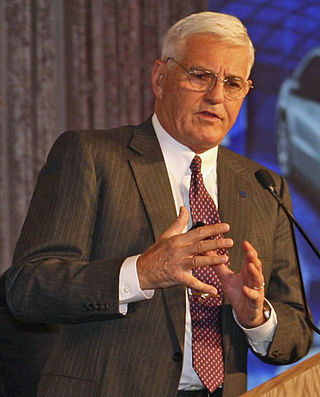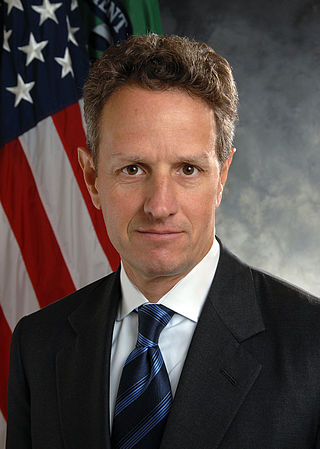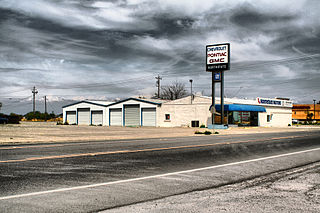Related Research Articles

Robert Anthony Lutz is a Swiss-American automotive executive. He served as a top leader of all of the United States Big Three automobile manufacturers, having been in succession executive vice president of Ford Motor Company, president and then vice chairman of Chrysler Corporation, and vice chairman of General Motors.

Steven Lawrence Rattner is an American investor, media commentator, and former journalist. He is currently chairman and chief executive officer of Willett Advisors, the private investment firm that manages billionaire former New York mayor Michael Bloomberg's personal and philanthropic assets. He began his career as an economic reporter for The New York Times before moving to a career in investment banking at Lehman Brothers, Morgan Stanley, and Lazard Freres & Co., where he rose to deputy chairman and deputy chief executive officer. He then became a managing principal of the Quadrangle Group, a private equity investment firm that specialized in the media and communications industries.

George Richard "Rick" Wagoner Jr. is an American businessman and former chair and chief executive officer of General Motors. Wagoner resigned as chairman and CEO at General Motors on March 29, 2009, at the request of the White House. The latter part of Wagoner's tenure as CEO of General Motors found him under heavy criticism as the market valuation of GM went down by more than 90% and the company lost more than US$82 billion. He is a board member of ChargePoint, an electric vehicle infrastructure company.

The Center for Auto Safety is a Washington, D.C.-based 501(c)(3) consumer advocacy non-profit group focused on the United States automotive industry. Founded in 1970 by Consumers Union and Ralph Nader, the group focuses its efforts on enacting reform though public advocacy and pressuring the National Highway Traffic Safety Administration and automakers through litigation. For decades, it was led by Executive Director Clarence Ditlow, who died in late 2016 from cancer. Ditlow was widely admired in the auto safety community, although he also had detractors among auto manufacturers. The Center for Auto Safety is currently led by Executive Director Jason Levine.
In the United States automotive industry, the term Big Three is used for the country's three largest motor vehicle manufacturers, especially indicating companies that sell under multiple brand names.

François J. Castaing was a French automotive executive with Renault, American Motors, and Chrysler. He was an engineering graduate from École Nationale Supérieure d'Arts et Métiers in Paris, and worked in Europe for Gordini and Renault before being named vice president for Product Engineering and Development at American Motors Corporation (AMC).

Advanced Technology Vehicles Manufacturing (ATVM) Loan Program is a $25 billion direct loan program funded by Congress in fall 2008 to provide debt capital to the U.S. automotive industry for the purpose of funding projects that help vehicles manufactured in the U.S. meet higher mileage requirements and lessen U.S. dependence on foreign oil. Of the 108 requests made, 5 were approved to receive $8.4 billion, with the majority of that amount under repayment.
The 2008–2010 automotive industry crisis formed part of the 2007–2008 financial crisis and the resulting Great Recession. The crisis affected European and Asian automobile manufacturers, but it was primarily felt in the American automobile manufacturing industry. The downturn also affected Canada by virtue of the Automotive Products Trade Agreement.

Timothy Franz Geithner is an American former central banker who served as the 75th United States Secretary of the Treasury under President Barack Obama from 2009 to 2013. He was the President of the Federal Reserve Bank of New York from 2003 to 2009, following service in the Clinton administration. Since March 2014, he has served as president and managing director of Warburg Pincus, a private equity firm headquartered in New York City.

Beginning in the latter half of 2008, a global-scale recession adversely affected the economy of the United States. A combination of several years of declining automobile sales and scarce availability of credit led to a more widespread crisis in the United States auto industry in the years of 2008 and 2009.

Ron Bloom is an American economic advisor who served as a senior official in the Obama Administration from February 2009 to August 2011. This included working as the Assistant to the President for Manufacturing Policy between February 2011 and August 2011, in the Department of the Treasury as a senior advisor to the Secretary of the Treasury, as a member of the President's Task Force on the Automotive Industry, and as senior counselor to the president for manufacturing policy. From 1996 to 2008, Bloom served as special assistant to the president of the United Steelworkers. Bloom also worked for the investment banking firm Lazard on two occasions, the second as Vice Chairman, U.S Investment Banking. Bloom is the vice chair and a managing partner of Brookfield Asset Management and served as chairman of the Board of Governors of the United States Postal Service.
Chrysler LLC and 24 of its affiliated subsidiaries filed a consolidated petition for bankruptcy on April 30, 2009, with the federal bankruptcy court in New York. The court filing occurred upon failure of the company to come to an agreement with its creditors for an outside-of-bankruptcy restructuring plan, by the April 30 deadline mandated by the federal government.
The 2009 General Motors Chapter 11 sale of the assets of automobile manufacturer General Motors and some of its subsidiaries was implemented through Chapter 11, Title 11, United States Code in the United States bankruptcy court for the Southern District of New York. The United States government-endorsed sale enabled the NGMCO Inc. to purchase the continuing operational assets of the old GM. Normal operations, including employee compensation, warranties, and other customer services were uninterrupted during the bankruptcy proceedings. Operations outside of the United States were not included in the court filing.
Indiana State Police Pension Trust v. Chrysler LLC was a lawsuit brought in United States federal court June 2009 by several pension funds against Chrysler LLC and the United States Department of the Treasury, to block the planned sale of Chrysler LLC assets to a "New Chrysler" entity in the Chrysler bankruptcy.
The Automobile Dealer Economic Rights Restoration Act (ADERRA), House Bill HR2743 and Senate Bill S1304, were introduced in the 111th United States Congress to restore the economic rights of car dealers.

In the United States, the automotive industry began in the 1890s and, as a result of the size of the domestic market and the use of mass production, rapidly evolved into the largest in the world. The United States was the first country in the world to have a mass market for vehicle production and sales and is a pioneer of the automotive industry and mass market production process. During the 20th century, global competitors emerged, especially in the second half of the century primarily across European and Asian markets, such as Germany, France, Italy, Japan and South Korea. The U.S. is currently second among the largest manufacturers in the world by volume.

The history of Chrysler involves engineering innovations, high finance, wide alternations of profits and losses, various mergers and acquisitions, and multinationalization. Chrysler, a large automobile manufacturer, was founded in the 1920s and continues under the name Stellantis North America.

Motors Liquidation Company (MLC), formerly General Motors Corporation, was the company left to settle past liability claims from Chapter 11 reorganization of American car manufacturer General Motors. It exited bankruptcy on March 31, 2011, only to be carved into four trusts; the first to settle the claims of unsecured creditors, the second to handle environmental response for MLC's remaining assets, a third to handle present and future asbestos-related claims, and a fourth for litigation claims.

Harry J. Wilson is an American businessman, former investor and turnaround expert who has served in the U.S. Treasury Department under President Barack Obama and on the 2009 Auto Industry Task Force. Wilson filed for office on February 16, 2010, running unopposed for the Republican primary for New York State Comptroller. He was defeated by incumbent Democrat Thomas DiNapoli in the general election on November 2, 2010.
The Canadian auto industry is closely linked to the U.S., due to the Automotive Products Trade Agreement and later the North American Free Trade Agreement (NAFTA), and is in similar trouble. Canada's 3,500 car dealers, which employ 140,000 people, told the federal and Ontario governments in mid-November they are at risk from the financial crisis; they are asking the national government to help out despite a record year of sales. Ottawa is considering providing financial aid to the Canadian subsidiaries of the Big Three, and possibly auto parts companies as well. The auto industry argued that loan guarantees and other help would try to save tens of thousands of Canadian jobs threatened by the sudden drop in North American car sales. Chrysler Canada has asked for $1 billion in aid, making it the only Canadian arm of the Big Three to make a specific dollar request.
References
- ↑ Press room "Treasury Announces Auto Supplier Support Program: Program Will Aid Critical Sector of American Economy", U.S. Dept. of the Treasury, March 19, 2009.
- ↑ Myerson, Harold. "The Case for Keeping Big Three Out of Bankruptcy", "The American Prospect", November 24, 008, retrieved December 7, 2008.
- 1 2 Press Room "Statement from Treasury Secretary Geithner on the Presidential Task Force on the Auto Industry" Archived 2009-09-17 at the Wayback Machine , U.S. Dept. of the Treasury, July 13, 2009.
- ↑ David Shepardson and Gordon Trowbridge. "Auto task force taking shape" February 21, 2009.
- 1 2 3 Press Room "http://www.ustreas.gov/press/releases/tg36.htm" Archived 2009-09-04 at the Wayback Machine , U.S. Dept. of the Treasury, February 20, 2009
- ↑ Stephen Manning. "Meltdown 101: What took GM and Chrysler so long?" Associated Press, May 29, 2009.
- ↑ "U.S. Government says it lost $11.2 billion on GM bailout". Reuters. 30 April 2014.
- ↑ Press room."Geithner, Summers Convene Official Designees to Presidential Task Force on the Auto Industry" Archived 2009-09-04 at the Wayback Machine , U.S. Dept of the Treasury, February 20. 2009.
- ↑ "The 31-Year-Old in Charge of Dismantling G.M." by David E. Sanger, The New York Times, May 31, 2009 (p. B1 6/1/09 NY ed.). Retrieved 6/1/09.